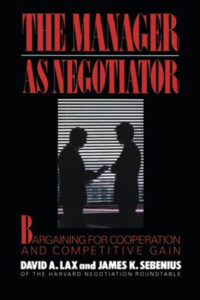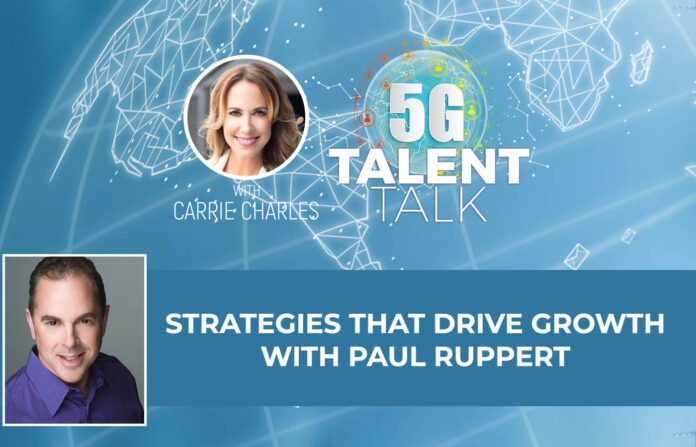Success in the world of technology requires not just innovation, but also strategic partnerships, skilled negotiations, and a relentless pursuit of growth. It’s about having the right people, the right intentions, and always staying relevant in an ever-changing landscape. In this episode of 5G Talent Talk with Carrie Charles, we’re joined by Paul Ruppert, a Harvard graduate, skilled negotiator, CPaaS veteran, and holder of two tech patents. Paul shares his secrets to scaling startups from zero to billion-dollar valuations, including how to negotiate high-stakes deals, build strategic partnerships, and stay relevant in a rapidly changing industry. He emphasizes the importance of continuous learning, adapting to new technologies, and always looking for ways to improve your skills. Tune in and learn from Paul how to drive growth and succeed in the world of technology.
—
Watch the episode here
Listen to the podcast here
Strategies That Drive Growth with Paul Ruppert
Welcome to the show. I am very excited to have you with me. I have a special guest that I’d like to introduce you to. His name is Paul Ruppert. He is a Harvard graduate, skilled negotiator, CPaaS veteran and holder of two tech patents. Let me tell you a little bit about Paul before we get started. Paul took an idea regarding SMS security and launched a service called Messaging Trust with AT&T. It generated $6 million in revenues in its 1st year. It also won the Global Product Award for Best Cybersecurity Solution from the GSM Association in 2013. This is how the data in our phones are kept safe.
Paul also led the development of the cutting-edge use of voice recognition by brokering a $6 million joint investment between Microsoft and AT&T to fund the trial launch of a service called Wildfire. This type of interface is what Apple adopted for the iPhone in 2010. We know her as Siri. Paul has a successful track record in the tech industry, having generated $400 million or more in tech sales over the past couple of years and engineered multiple trade acquisitions. His clients include Facebook, MasterCard, Western Union and multiple private equity firms.
—
Paul, thank you for joining me. There is so much to talk about here and many questions I want to ask you.
Carrie, thank you very much for the invitation and the opportunity to speak to your audience. It’s great to be here.
You have scaled startups from zero to billion-dollar valuations. Talk a little bit about this. I want to hear the how and the why. That could take days and years but it’s exciting what you’ve done.
I will probably look back on being involved in a startup after having been inside AT&T. Back then, it was Pacific Bell Mobile Services, one of the first GSM operators that we launched in North America. I had the opportunity to join a startup that was called Mobile 365. It became one of the pioneering leaders in the messaging interoperability space.
One of those patents that I have is the ability to be able to send a text message from what’s called the native GSM radio format to the non-GSM radio format. In layman’s terms, that means that a message from, let’s say, Vodafone in the UK, which is known as T-Mobile US in the US, to Verizon could occur. That was back in 2001. That was a great run. We went from 0 to about $120 million in revenues and a $430 million liquidity event and exit in 5 years. It may not have been a unicorn but it was certainly a soonicorn in the context of where our growth rate was. We decided to sell the company instead of doing an IPO for Holst of all the reasons.
I’ve also been involved in other initiatives since then in the messaging space specifically. You mention a lot of my clients. I’m an advisor and consultant to many private equity firms that are looking to make investments in this space. I help them do commercial due diligence and assess what the opportunities and risks might be around those types of investments.
You’ve done a lot of high stake deal negotiations in your past. Can you tell me maybe a couple of tips for those of us who would like to learn this style of negotiation?
I come to it from a different perspective. I’m not a technologist. I’ve got a graduate degree in Public Administration from the Kennedy School of Government at Harvard. How you get from that to having developed two patents in messaging interoperability is not the most linear path. In my experience, professionally, I’ve been called an ambidextrous executive. What does that mean? It turns out that I have both private sector experience that you’ve highlighted here but prior to that, I also had public sector experience.
In my public, it’s what I would call political sector experience. Right out of college, I was serving as a legislative assistant to a US senator named John Danforth from Missouri. I eventually became an Economic Development Policy Advisor to Secretary Jack Kemp at the Department of Housing and Urban Development. He is a political strategist on political campaigns and a technology trade association lobbyist. That gave me exposure to high-stakes negotiations. All negotiations are high stakes but that is where I cut my teeth in it.
That is my perspective in terms of being able to develop coalitions and partnerships. When you walk into any type of negotiation, you’re talking about a relationship. Sometimes, a relationship is between you and your counterpart in the room. Many times, there’s also a third party in a number of different forms or fashions, whether it might be the public interest, public good, shareholders or board members. It all depends on the environment that you’re operating in.
When you walk into any type of negotiation, you’re talking about a relationship.
For your audience, if you want to get an insight into a somewhat academic but still nonetheless very approachable and understandable book or books on negotiations, one is called The Manager As Negotiator. It’s written by a Harvard Business School professor. His name is James Sebenius. Professor Sebenius has been teaching negotiation analysis for over 30 years at Harvard Business School. That’s where I took his course. He’s also got another book that he came out years ago called 3-D Negotiation. Both are great treatises and foundations on how you might want to approach negotiation, whether it’s the most mundane thing or the most high-stakes.

I get the feeling that you think differently than most people. I’m curious. How do you spot trends? How do you draw these connections and be able to see the big picture ahead of you?
The problem with high technology, specifically in the mobile telephony world and I know you’re a veteran of this space as well, is the reality that many times, you have people who are very linear and are good with one thing and have been doing that for a very long time. This is the Malcolm Gladwell, “If you do something 10,000 times, you become an expert.”
My counter is if you have a range of skills, you are much more suited to be able to identify and be more creative in your problem-solving. That’s how I explain how I see the world. In the Japanese business world, there is a term called the Galapagos Syndrome. This exists. It talks about how specialized or isolated development makes a solution incapable of competing in dynamic and agile developments or environments outside of that. This goes to Charles Darwin where Darwin was talking about the species on the Galapagos Islands that were thriving there. Once they got outside of that environment, they failed. They didn’t survive because they didn’t have the ability to pivot, think differently and have that agile capability. That’s how I look at the world.
Many years ago and we had talked about this in our pre-call, I used to write a blog on Mobile Point View. It was a website that I had at the time. I coined a term called innovisioneering. It comes down to how you hunt for innovations and what’s the process of developing innovation and hunting. In my hunting, I thought, “We’re looking at innovation. We have to have the right vision.” It’s not engineering. I combined it to create orienteering because you are looking for the relationships or the adjacent opportunities, not just the problem that you’re facing that may be one-dimensional. That’s how I think about things a little bit differently.
Let’s go back to messaging. What are you seeing as trends in messaging, let’s say, in the US or even globally?
All trends are international and global, first and foremost. It’s primarily because of the nature of telecommunications that it is, by definition, a global initiative. Secondarily, I’ve been in this space since its breakout where originally, text messaging or SMS was 160 characters that were not used for a communications solution. It was to enable such things as one-time passwords and other types of services to turn on solutions that a mobile network operator would be able to deliver to your handset.
An adjacent opportunity was exploited here where some engineers were like, “We could fit 160 characters into this. Maybe we should try that.” It turned into a cultural and historical phenomenon. When we start talking about SMS, we’re talking about fifteen trillion text messages that are sent globally into the ether every year.
Where we are is there’s a solution and capability of the industry called CPaaS. This is a SaaS commercial model, a Software as a Service solution, which means that it’s in the Cloud. You are integrating a number of different telecommunications platforms, which primarily include SMS but also include voice or video, as well as over-the-top capabilities. That is another form of messaging that is delivered through solutions like WhatsApp, Viber and Facebook. As well as in-app push messaging, which is also a form of messaging and then even legacy-style email. That’s all combined in an artificial intelligence solution.
The objective here is how enterprises can more effectively communicate with their consumers. That’s the communications platforms as a service element. It could be enhancing digitalization within the internal operations of an enterprise. That’s usually called CCaaS. These are the two directions that we’re going in messaging.
One thing that’s so important in our industry in every single area is cybersecurity. What opportunities do you see in the mobile cybersecurity segment?
This is the term that’s been in place for several years in terms of the threat to broader networks. You can have a sub-segment of that, which is the threat to specific mobile networks. Mobile networks have been pretty sound in terms of their security capabilities. You don’t hear anything about a hack of a mobile network operator primarily because of the nature of firewalls and the way these are all segmented out. One of the things that I’m interested in is the application of quantum computing. It is a different style of computing structure than the classical architecture that we use using bits and bytes. This gets into high-level science that’s well beyond me.

The reality is that this is the direction that we’re heading primarily because quantum computing makes computing so much faster. It is a quantum level faster that more data can be analyzed, predicted and defended against various types of fraud or any types of eavesdropping. This is gaining a lot of traction in the intelligence community, the National Security Agency and things of that nature. This could also be applied in my view and for others who are active in the business in the telecommunications space, whether it’s repeaters, network functionality or being able to monitor and patrol the trillions of messages that are out there.
We’re going to talk about people. You are masterful with strategic partnerships.
That’s very kind of you.
Look at what you’ve accomplished. You’ve had to do it through people. I’m curious when it comes to these partnerships and creating them and nurturing them and this engagement from customers, how do you navigate all of that? How do you make sure that you have the right people and the right intentions and that everything’s moving in the right direction? It’s huge in business. That’s our number one objective. It is making sure that we have the right relationships and it’s accomplishing what we need to accomplish.
I once had a conversation with another podcast host who went deep on this as well. My upbringing probably trained me for capabilities later in life to see commonalities instead of differences. That’s primarily because as a child, I used to travel to Europe with my mother who’s French. I am half-French. As a result of that, I was able to see a very different world primarily because the cultures in Europe were different from the cultures in the US.
Along the way, whether it was my operating in the political/public realm or even in the industry/private sector realm, I see, for example, telecommunication’s simple product. We’re talking about minutes in messaging but it’s applied to billions of people and hundreds of cultures and languages. I look at problem-solving. It goes beyond the mechanics of how something works or the face value of the problems. Instead, I look to understand who will use it and why.
I try to go a couple of layers deeper than more conventional analysis. When you start asking such questions, it becomes like, “I’ve got to contemplate my navel here as to what makes me different or similar and how I’ve been able to leverage that.” With the successes, it doesn’t mean it’s all been successful. We all have failures in life. That’s how I approach these things to try to make my way through life.
With the successes, it doesn’t mean it’s all been successful. We all have failures in life.
I love the commonality piece because we all like people who are like us. We have something in common with every single person that we come across. That helps to create and also maintain those partnerships. The talent landscape is changing. The world is changing as well as technology, automation and workforce trends. We have fewer people in the workforce. There is a lot of noise out there around this. What are your thoughts on what type of talent will thrive in our new world of work and our industry with broadband, 5G and everything happening?
I’m going to throw another book at you. You should pick up the book that’s titled Range. It’s written by an author named David Epstein. I was utilizing some of the concepts that he talks about, which is that you’ve got to have talent that is broadly trained, not just in their approach. I’ve been advising a son of a friend of mine who’s extremely successful in the IT world. He’s got an undergraduate degree from Cal in Computer Science.
He’s spent the last couple of years in that realm. I’ve been trying to counsel him that he needs to be able to broaden his perspective. Otherwise, he’s going to be very narrowly defined as he moves forward in his career. That means that his opportunities may not be as broad as he would like or hope. The obvious direction that I’ve been trying to tell him is, “Maybe you should be reading other things. Try Sun Tzu, The Art of War.” It’s rarely going to be talked about in a Computer Science program but it does get addressed in a Public Administration program, Business School program and a host of different environments.
The point here is that you’ve got to have multiple skillsets and a range of vision to be able to solve the problems that are going to be manifold, integrated, interconnected and interdependent as we move forward. I look at things like climate change. If you’re looking at it from one perspective, you’re not going to be able to integrate and have an understanding of the broader implications as well as being able to create a solution to be able to deal with that. That is why it’s one of the biggest problems we’re facing.
You need a range of vision and multiple skill sets to solve the problems that are going to be manifold, interdependent, integrated, and interconnected as we move forward.
There’s this segment of the workforce that’s middle-aged. That’s what I feel like I am. Many of us have been working in one area for so long. We know this area well but this area is changing. What do we do at this age to say, “How do I keep myself and my skills relevant? I want to make sure that I have the ability to grow with this new world of work in technology.”
That is very dependent upon the individual’s circumstances. The reality is that you’ve got to be agile and nimble in everything that you undertake. Let me throw that back to you. Would you have been thinking that you would be doing something like a radio show for a decade? If you had asked me, “Would you be expecting to be a guest on a quasi-radio show,” we’re talking about podcasts and where we are, the answer would’ve been, “No, not really.”
The reality of how you’d be able to send your message as to who you are as well as the value proposition is much about relationships because you are establishing relationships with hundreds of people who’ve been guests on your show. There’s the people aspect. The vision element is, “Can you look beyond or over the horizon?” That is another term that I often use in terms of being able to analyze a problem.

You have a big-picture perspective of things instead of that small-picture perspective of overseeing the operating performance, the engine performance of your company or whatever you might be doing. That is whether you might be an accountant or whatever it might be. That means not being so narrowly defined and then understanding that you can make those changes. Let’s call it faith in your ability to move forward.
I hear you saying grow, learn and take risks. Step out of that comfort zone and that box. I love that. What are you doing? I want to hear more about that. You mentioned it a little bit in the beginning but what’s next for you? What’s on the horizon? Is it another billion-dollar company?
Back to where you are in the journey, what I do is I’m a consultant back to the industry that I grew up in. I consult clients who’ve been involved with Infobip and Route Mobile, as well as others lists that I could go through that most of your audience probably has never heard of. I also do a lot of work with private equity firms including The Carlyle Group, H.I.G Capital and the National Bank of Kuwait. It is a very interesting dynamic and project.
I am providing insight in terms of mobile technology and then being able to progress that forward into new opportunities, new ventures and new investments. I still have a hand in helping others identify that next unicorn, wherever it might be. To new opportunities, I’m always open to a conversation with anyone who’d like to consult as to how I might be able to help them in terms of taking their company to the next level or next stage and looking for strategic guidance, which is what I provide.
This has been fantastic. I’ve learned a lot. How can we reach you?
You can go to LinkedIn, which everybody does. I’m listed as Paul R. Ruppert. You can also go to my website, which is www.GPVLTD.com. It stands for Global Point View, which is the name of my consulting company. That’s the best way to reach out to me and I know people do.
I found it fascinating to talk to you. It’s the second time. I hope that we can stay in touch. Thank you so much for coming to the show.
Thank you, Carrie. It’s great to be here.
Take care.
Important Links
- Paul Ruppert
- The Manager As Negotiator
- 3-D Negotiation
- Range
- The Art of War
- Paul R. Ruppert – LinkedIn
About Paul Ruppert
 CEO Global Point View – CPaaS, Mobile Services expert, Start up scaler, Global Sales expert, Negotiator, Strategic Partnerships.
CEO Global Point View – CPaaS, Mobile Services expert, Start up scaler, Global Sales expert, Negotiator, Strategic Partnerships.
Paul Ruppert is a veteran CPaaS and mobile services executive, strategy consultant and holder of 2 tech patents enabling global text messaging, with career experience in both the private and public sectors applying a range of multidisciplinary skills exercised at the highest levels of both arenas–from corporate boardrooms to the White House.
He has generated over $400M in direct sales, is a skilled cross border negotiator, technology innovator and strategic partnership driver with two decades leading global commercial, product, marketing teams and M&A deals in B2B SaaS sales. Prior to entering the private sector, with a Harvard masters graduate degree Paul served over a decade in policy and political roles as an legislative assistant to a US Senator, economic development advisor to a cabinet Secretary, a technology industry lobbyist and White House staffer.
His private sector achievements are exceptional including scaling startups from $0 to $Billion valuations, forging global strategic partnerships, doing business in 80 countries, working with private equity and $B enterprises managing $130M business P&Ls, and managing cross border, cross cultural teams of teams having lived in the US, France and China.
Paul is the President of Global Point View Ltd, a strategy consulting firm providing insights to technology companies seeking guidance on focus, strategies and plans via scaling, partnerships and acquisitions.
His international clients have included Facebook, MasterCard, Western Union, Liveperson, Infobip, private equity and venture firms looking to leverage mobile services in their digital plans for conversational commerce.

